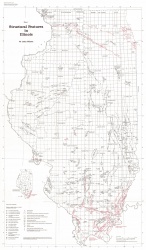Colmar Anticline
Location
Southwestern McDonough and adjacent parts of Hancock and Schuyler Counties (E-2)
References
Hinds 1914, 1919, Morse and Kay: 1915, Howard 1961
Description
Hinds (1914) mapped an anticline south of Colmar and recommended the area for oil prospecting. In the same year the Colmar-Plymouth Oil Field was discovered; the lenticular Hoing Sandstone (Middle Devonian) is the producing horizon. Morse and Kay (1915) mapped a dumbbell-shaped anticline that trends east to west and is contoured on the Hoing. Hinds (1919) was the first author to call this structure the Colmar Anticline.
A structure map contoured by Howard (1961) on top of the Galena Group (Champlainian) shows several irregular areas of closure in the Colmar-Plymouth field. The name Colmar Anticline is retained for the largest area of closure, which has a strongly curved axis (plate 1). Howard shows about 60 feet (18 m) of maximum closure on the Galena and states that 80 to 100 feet (24-30 m) of closure exists at the base of the New Albany Group (Upper Devonian). A smaller area of closure roughly oval in plan view, occurs north of the main Colmar Anticline. Oil accumulation in the Colmar-Plymouth field was controlled partially by structure and partially by stratigraphic factors.
